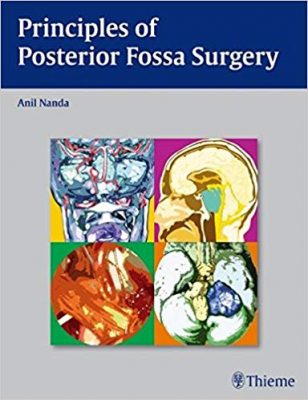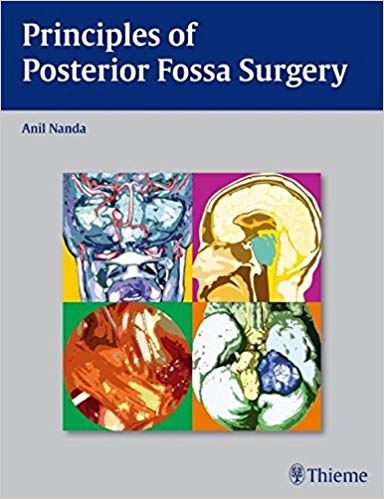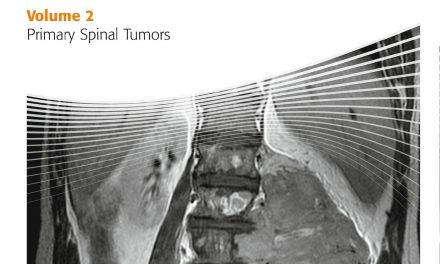 Editor: Anil Nanda, MD
Editor: Anil Nanda, MD
Publisher: Thieme – 252 pages
Book Review by: Nano Khilnani
Navigating the terrain of the posterior fossa can often be intimidating to the beginning neurosurgeon. This book has been written to make that exploration easier for the uninitiated, and eventually, surgical treatment, successful.
Forty-seven specialists in neuroanatomy, neurology, neurosurgery, otolaryngology, and related fields from all over the United States and five other countries – Australia, Canada, Germany, India, and Japan – authored the 25 chapters of this book We list them below to provide you an overview of the contents of this book, organized around four sections:
- General Considerations
- Surgery for the Posterior Cranial Fossa: Historical Aspects
- Microsurgical Anatomy of the Posterior Cranial Fossa
- Neuroimaging of the Posterior Fossa
- Neurosurgical Pathology of the Posterior Fossa
- Neurologic Entities of the Posterior Fossa
- Disease-Based Management
- Congenital Chiari Management
- Trauma to the Temporal Bone
- Posterior Fossa Infections
- Temporal Bone Surgery
- Hemangiomas and Dural Fistulas
- Surgical Techniques
- Basic Concepts on Posterior Fossa Surgery
- Surgical Management of Petroclivial Tumors
- Jugular Bulb Tumors
- The Retromastoid Approach: Techniques and Results
- Acoustic Neuromas: Translabyrinthine Approaches
- Middle Fossa Craniotomy
- Microvascular Decompressions for Hemifacial Spasm and Trigeminal Neuralgia
- Management of Posterior Cranial Fossa Pathology: Gamma Knife Radiosurgery
- Aneurysms of the Basilar Trunk: For Lateral and Petrosal Approaches
- Approaches and Management of Basilar Tip Aneurysms
- Endovascular Treatment of Posterior Circulation Aneurysms
- Posterior Interhemispheric Approach to Pineal Region and Brainstem
- Posterior Fossa Arteriovenous Malformations and Cavernous Angiomas
- Miscellaneous
- Shunt Surgery for Posterior Fossa Legions
- Surgical Management of Pediatric Posterior Fossa Tumors
To get an idea of what you will find within the chapters, let us take a look at the outline of chapter11, Basic Concepts in Posterior Fossa Surgery, authored by Lissa C. Baird, Vijayakumar Java;kar, and Anil Nanda. This is the first of 13 chapters in Section III entitled Surgical Techniques.
In the introductory paragraphs of this chapter, the authors make the following important points:
- The neural structures found within the limited space of the posterior fossa region control some of the most critical functions of the central nervous system
- Some of the risks if a mass lesion is to form in this location are:
- Brainstem compression
- Herniation
- Death
- Advances in anesthesia, aseptic technique, neurologic localization and developments in technical tools and skills now allow for safe and effective surgical treatment options
- Two standard approaches are used to access most of the posterior fossa pathology:
- Midline sub-occipital approach
- Retromastoid approach
The rest of the contents of this chapter are organized within these topics and some subtopics shown below. We’re not going to list sub-subtopics due to our policy of not making book reviews too detailed:
- Preoperative Management
- The Midline Sub-occipital Approach
- Positioning
- Landmarks
- Surgical Technique
- Cerebellomedullary Approach to the Fourth Ventricle
- Closure
- Pitfalls and complications
- The Retromastoid Approach
- Positioning and Incision
- Landmarks
- Surgical Technique
- Cerebellomedullary Approach to the Fourth Ventricle
- Closure
- Pitfalls and Complications
- Postoperative Care
- Complications and Their Avoidance in Posterior Fossa Surgery
- Cerebrospinal Fluid (CSF) Leaks
- Wound Infection and Meningitis
- Aseptic Meningitis
- Cerebellar Mutism
- Pseudomeningocele
- Cranial Nerve Palsies
- Postoperative Hematoma
- Posterior Fossa Edema
- Hydrocephalus
- Conclusion
- References
The posterior fossa is an anatomically challenging region for trainees and even for neurosurgeons. In order to be successful, a thorough and detailed knowledge and understanding of this region’s structures and their physiology is critical. This book, with chapters written by a highly qualified team of specialists, provides in-depth coverage of this highly complex surgical region.
Chapters on this area’s pathology, imaging, management of various diseases, and importantly, surgical techniques to achieve the most desirable outcomes. are provided. This book is useful for established neurosurgeons, as well as medical residents and fellows.
Author:
Anil Nanda, MD, MPH, FAANS is a Professor at, and Chairman of the Department of Neurosurgery at Louisiana State University Health Sciences Center in Shreveport, Louisiana.







